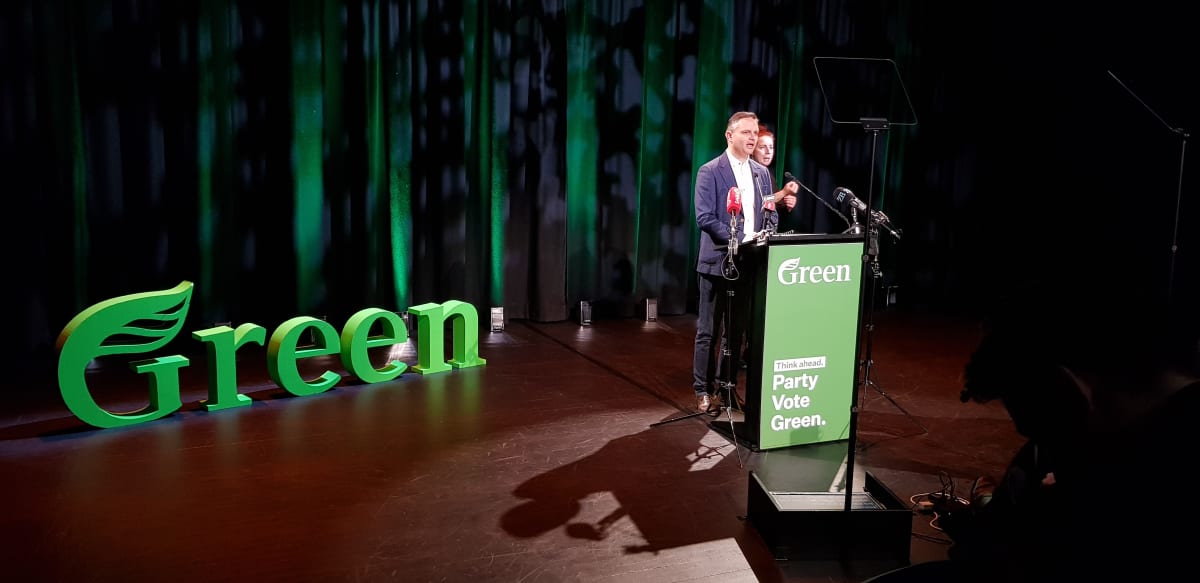Solar panels and batteries would be installed in 30,000 State homes to create a “virtual power plant” if the Greens get their way after the election.
The party launched its clean energy policy at an event in Wellington at Te Auaha – the New Zealand Institute of Creativity. Its promises include the repeat of a 2017 election promise to transition the country to a 100 percent renewable energy electricity supply by 2030 (the current Government target is 2035).
Green party co-leader James Shaw said the Government they had been a part of had done more to reduce emissions in the last three years than all governments in the last 30 years combined.
“When we came into government we committed to changing the rules.”
He signalled there would be a major focus on installing solar panels in private and state homes, along with a ban on new non-renewable industrial heating systems if the party formed part of the next government.
“It makes sense to use the sun to heat our homes. To keep the lights on and to power our cars.”
What’s different this time?
Shaw said the party had pushed for the 2030 renewable energy target during coalition negotiations in 2017, but did not have the information to make the case for it.
In 2018 interim climate change commission had also said the 2030 target would be “a stretch”, but Shaw noted the commission had signalled there were options like pumped hydro that could help them meet that target.
“At the time we didn’t have as good information because we were just coming into government. Now we’re sure of what we’re doing.”
“The technological options have become more available and cheaper than they were when we first said that.”
‘Virtual power plant’
The party has proposed installing solar panels and batteries in just under half of all state homes at an estimated cost of $537m then sharing the electricity generated with other households through a “virtual power plant” arrangement.
“The virtual power plant makes the whole thing work. If it was just about individual houses then actually it wouldn’t work.”
“If you take tens of thousands of houses who have each got rooftop solar plus battery you can knit them together and actually form the equivalent of a gas peaking plant.”
The Greens estimate this arrangement will generate 250MW of electricity – mainly in the Upper North Island – half of what the remaining coal-and-gas-fired turbines at Huntly generates.

For private homeowners the Greens will give government grants to cover half of the upfront cost of a 4kW solar and battery system. The scheme will cost $269m over three years, but the Greens estimate it will save households $500 a year on their electricity bill.
“I’m not going to get into ranking our priorities, but the announcements that we’re making…will give you a sense of what the things are that we will be negotiating most hard for.”
The virtual power plant concept is currently being trialled by Genesis energy in Wairarapa. It aims to allow homes to pump the excess solar energy they generate into the electricity market in the same way a real-life power plant does today.
It’s not the only scheme that’s in the mix to support better energy use within private households. The Greens are also in favour of replacing lightbulbs in private households with LED lighting.
Their policy would see the Government pay to provide five LED lightbulbs for every household. They estimate this will wipe $105m every year off electricity bills and eliminate 177,000 tonnes of carbon emissions (the equivalent of taking 38,000 cars off the road).
All elements of the party’s clean energy policy have been costed at $1.3b combined.
A ban on new coal boilers
The Greens have also promised to ban the purchase of new industrial heating equipment fired by fossil fuels within its first 100 days in government.
It will also launch a review to consider the creation of a new Ministry of Energy and Decarbonisation.
Emissions from industrial heating processes make up one-third of our overall energy use and contribute approximately 9 percent of New Zealand’s gross emissions
Sixty percent of heat from industrial processes are supplied through the burning of fossil fuels like coal and gas.
They plan to replace this industrial technology with “clean” alternatives by 2030 for coal and 2035 for gas.
This will be supported by a grant or low-cost loan from the government – tripling the funding available to an existing scheme that does the same – from $33m to $100m a year.
Shaw refused to say which of the party’s clean energy plans would be a bottom-line during coalition negotiations to form a future government.
“I’m not going to get into ranking our priorities, but the announcements that we’re making…will give you a sense of what the things are that we will be negotiating most hard for.”



